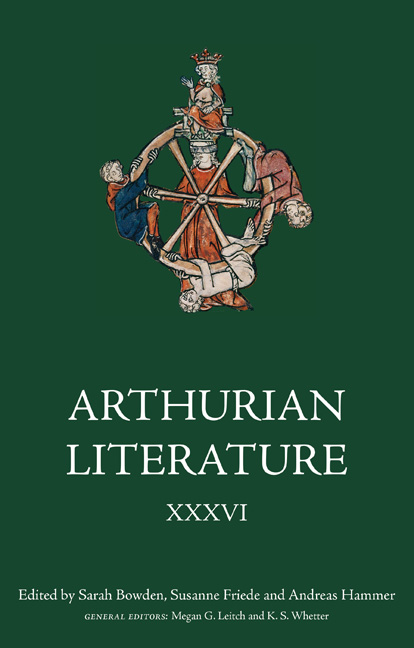Book contents
- Frontmatter
- Contents
- General Editors’ Preface
- List of Contributors
- Introduction: Sacred Space and Place in Arthurian Romance
- 1 The Church and the Otherworld: Sacred Spaces in the Matière de Bretagne and Medieval Ireland
- 2 Sacred Spaces: the Syntagmatic and Paradigmatic Construction of Narrated Space in Chrétien’s Conte du Graal
- 3 Perceiving the Way: Sacred Spaces and Imaginary Pilgrimage in the Vulgate Cycle Queste del Saint Graal and Thomas Malory’s ‘Tale of the Sankgreal’
- 4 Affirming Absence and Embracing Nothing: on the Paradoxical Place of Heterosexual Sex in Medieval French Verse Romance
- 5 Spaces of Remorse: Penitential Allusions in Iwein
- 6 The Spatial Narratives of Salvation and Damnation in Wigalois and the Prose Lancelot
- 7 ‘Fantoum and Fayryȝe’: Visions of the End of Arthurian Britain
- 8 The Tomb of the Kings: Imperial Space in Arthur’s Camelot
- Contents of Previous Volumes: Details of Earlier Titles are Available from the Publishers
6 - The Spatial Narratives of Salvation and Damnation in Wigalois and the Prose Lancelot
Published online by Cambridge University Press: 17 April 2021
- Frontmatter
- Contents
- General Editors’ Preface
- List of Contributors
- Introduction: Sacred Space and Place in Arthurian Romance
- 1 The Church and the Otherworld: Sacred Spaces in the Matière de Bretagne and Medieval Ireland
- 2 Sacred Spaces: the Syntagmatic and Paradigmatic Construction of Narrated Space in Chrétien’s Conte du Graal
- 3 Perceiving the Way: Sacred Spaces and Imaginary Pilgrimage in the Vulgate Cycle Queste del Saint Graal and Thomas Malory’s ‘Tale of the Sankgreal’
- 4 Affirming Absence and Embracing Nothing: on the Paradoxical Place of Heterosexual Sex in Medieval French Verse Romance
- 5 Spaces of Remorse: Penitential Allusions in Iwein
- 6 The Spatial Narratives of Salvation and Damnation in Wigalois and the Prose Lancelot
- 7 ‘Fantoum and Fayryȝe’: Visions of the End of Arthurian Britain
- 8 The Tomb of the Kings: Imperial Space in Arthur’s Camelot
- Contents of Previous Volumes: Details of Earlier Titles are Available from the Publishers
Summary
The narrative order and textual arrangement of a story are frequently made apparent in the way in which the plot constructs and makes use of space. Jurij Lotman was one of the first to describe this phenomenon, with a focus on the linguistic dimension. He identified a connection between the space of a narrated world and the ethical values inherent in the narration and their cultural context (for further examples see this volume's Introduction, pp. 3–4 and 7). As discussed in the Introduction to this special issue, a number of different theoretical concepts have since emerged that aim to describe spatial structures in order to expose the cultural constructions determined by the use of space. The philosopher Ernst Cassirer, for instance, comprehended myth as a form of thought that recognizes different qualities of space; and Michel Foucault developed the concept of the ‘heterotopia’ in contrast to the utopia: real (that is to say, not fictional) places, which differ in their spatial order from so-called normal space and which are often connected with specific values and cultural terms.
In medieval literature, such ethical values and cultural norms are affected by Christianity. The ordo of Christianity also influences Arthurian romance: the idea of chivalry in the Arthurian romances of the medieval period springs from a Christian ethos. Knightly virtues derive from Christian values and norms, and protagonists act as saviors and redeemers. At the same time, however, the heroes do not follow Christ's example in the sense of an imitatio Christi. The narratives in which they appear – in the German context Hartmann von Aue's Ereck and Iwein and other early works in particular – strike a balance between courtly ideals and kingly rule.
Since Christian values are often only present implicitly in Arthurian romance, the relationship between space and narrative becomes more interesting. As a result, sacred spaces and their relationship to the protagonists as well as to the narrative structure can highlight the significance of religious values. The majority of spaces in Arthurian literature do not have religious connotations, but spaces or buildings (and not only churches) that are marked out as sacred do occur and can point to the specific relevance of certain religious values instead of or alongside courtly ideals.
- Type
- Chapter
- Information
- Arthurian Literature XXXVISacred Space and Place in Arthurian Romance, pp. 125 - 148Publisher: Boydell & BrewerPrint publication year: 2021



